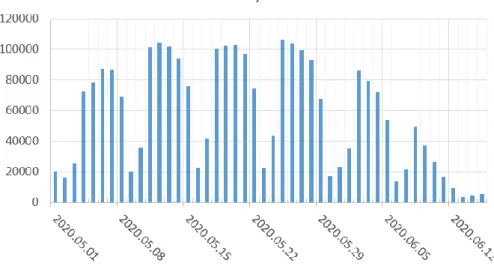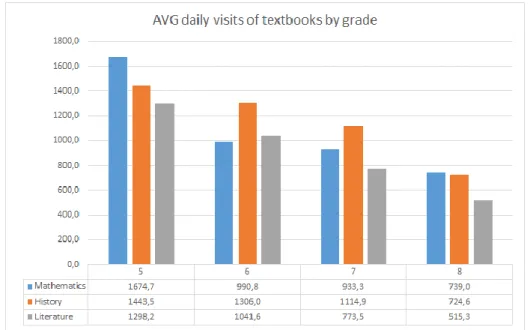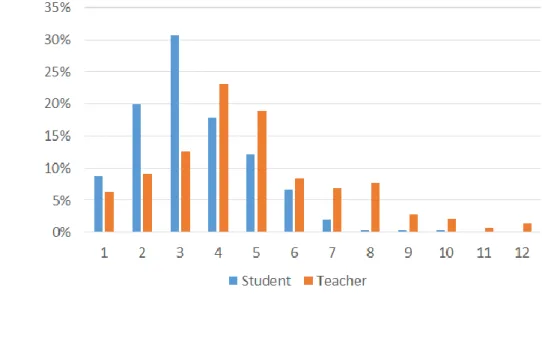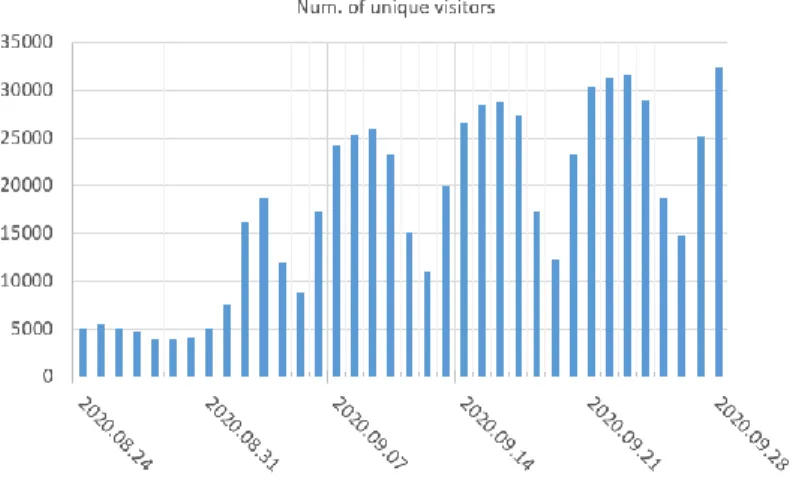231 https://doi.org/10.17048/AM.2020.231
Pap Melinda
Eszterházy Károly University
pap.melinda@uni-eszterhazy.hu
Kvaszingerné Prantner Csilla
Eszterházy Károly Universitykvaszingerne.prantner.csilla@uni-eszterhazy.hu
Vígh Imre
Eszterházy Károly University
vigh.imre@uni-eszterhazy.hu
Experiences of the NKP 2.0 educational portal during COVID-19 pan- demic induced online education
Abstract
Due to the COVID-19 pandemic, most countries had to switch to online education from one day to the other. To aid the educators and students, the NKP 2.0 national educational portal was made pub- licly available by the Hungarian government in March 2020. This sudden emergency situation urged us to renew and reform the current learning methodologies. Thus, it can be viewed as an accelerator of advancements in this field.
The requirements stated in the Hungarian Digital Educational Strategy were almost fully met by the NKP 2.0 portal. It also gained high popularity since its announcement, the number of unique visi- tors per workday was reaching 82 000. This is a considerable amount, knowing that the number of children in Hungary between the age 7-18 is around 1 million.
In this paper we briefly introduce the learning methodological background of the NKP 2.0 portal, and we also describe its main components and intelligent solutions. Furthermore, we present statis- tical foundings of the usage of our portal during the pandemic, i.e. for what tasks, on which devices and how people were using it. At the end of this school year we carried out a survey to assess user satisfaction, the results of these questionnaires are presented in this paper.
232 Keywords: Learning Content Management System, COVID-19, online education, mobile education
1. Introduction
A novel virus (COVID-19) emerged in December 2019 from China. The number of new infections increased rapidly and spread across the world. In February 2020 the World Health Organization (WHO) recognized this situation as an international public health emergency and urged the countries to act upon the new pandemic. The WHO issued recommendations, such as education of the popula- tion about the virus, social distancing, travel avoidance etc.
According to the United Nations Educational, Scientific and Cultural Organization (UNESCO), by the 1st of May 2020, over 1.5 billion learners were affected by country-wide school closures, that is about 91% of the total enrolled learners throughout the world. 193 country closed their schools, and many changed their learning system to fully digital education. In Hungary 1.7 million learners were affected by this decision, when the Hungarian Government announced the total school closure start- ing from 16. March and required the immediate transition to distant, digital education.
There are three main types of online learning: asynchronous, synchronous and hybrid online courses. Asynchronous online courses do not take place in real-time. The learning material and as- signments are available for learners within a given time frame. The communication and interaction happens via forums, blogs and wikis. In the case of synchronous online courses there is an instructor available for the learners and the communication happens simultaneously, in ether textual or verbal form e.g. via live chat or video conference. Hybrid courses, i.e. blended courses incorporate face-to- face interaction as well as online forms of communication.
After the school closures, the educators had to switch from the traditional face-to-face instruc- tional methods to more indirect ones and decide what type of online learning (synchronous or asyn- chronous) and which tools they use for their work, so that the education could continue uninterrupt- ed. There are plenty of systems currently available to support teachers world-wide, offering a wide range of services.
In this paper we aim to analyze the behavior of teachers and students in this changed learning en- vironment. We made our observations with the aid of the NKP 2.0 portal, that is a learning manage- ment system (LMS) that supports asynchronous online learning.
2. Literature
There has been several publications recently in the topic of COVID-19 induced transition to online education. A paper from China (Dong et al, 2020) assessed the satisfaction of teachers and parents
233 regarding the distance education of young children (between age 3-5). Most of the parents in China are sceptic about online education. Over 3000 parents participated in the survey, 93% of them claimed that their children participated in online education, however, 85% of the children spent less than half an hour with distance learning. The authors claim that the basis of parental skepticism and rejection is based on the observation that their children have no or low self-regulation, they were uninterested in online learning and the parents did not have time to support their children in their education at home beside their jobs. A study from the Gaza strip (Radwan et al, 2020) shows that the school closures had a great economic and social impact, because it influenced the parents ability to work. 78% of the interviewed households reported wage loss during this period.
The authors of (Chen, T., et al, 2020) surveyed the user satisfaction of learners and educators in China regarding the available online education platforms. They posed questions, such as what were the mayor issues and complications they faced and what did they find the most useful functionality.
They concluded that the satisfaction of users were less dependent on their personal factors and more on platform availability and the available support. The authors constructed a satisfiability index using the ones already discussed in the literature and incorporating machine learning based emotion analysis, then used a neural network to forecast the overall satisfaction. Based on the resulted scores, the authors provided suggestions for the improvement of platforms to increase user satisfac- tion and improve the quality of online education. The recommendations were e.g.: responsivity of the page to support mobile devices, development of a dark mode, solving the issues of internet lags and network congestion and providing a responsive help desk/customer support, etc. They conclud- ed that the accessibility and quality of interactions and services are important factors of user satisfac- tion. In Georgia, the authors of (Basilaia, et al, 2020) also observed an educational platform, namely, the one that was provided by their government. They studied the first week of offline-online educa- tion transition, with respect to the available support helping the educators make the sudden change in their methods. They made similar conclusions as the authors of (Chen, T., et al, 2020), the interac- tions enabled by the platforms should be improved. The importance of personal evaluation in- creased, since the online education requires more self-regulated learning. They claimed that the transition was made successfully and the experiences collected during this period will be utilizable even after the pandemic.
3. Data collection
To collect data on the behavior and interaction of teachers and students, we used the NKP 2.0 na- tional educational portal that is based on the Ekernel system described in (Pap, M., Nagy, L. Z., &
Fekete, D., 2020). This platform was developed in 2019 and was made publicly available at the be-
234 ginning of 2020. This is a Learning Management System (LMS) that is used for delivering, tracking and managing training and education.
It does not only allow users to create content and to interact, but it already has a huge database of learning materials. By the time of the school closures, our editorial community of 250 users has written and validated 83 textbooks, containing 4 568 lessons. Furthermore, 14 247 interactive exer- cises were created.
The main functionalities of the NKP 2.0 portal are as follows: online textbooks, exercise and test creation, sharing and evaluation, internal messaging service, study groups with forums. It supports asynchronous online learning.
To collect the usage data, we have used Matomo, an open source web analytics application. It is able to track visits to more websites and provides rich traffic analytics. Besides monitoring the user activity, we also published an online questionnaire on the NKP 2.0 portal, that the registered users could fill out voluntarily. The questionnaire mainly focused on the users’ basic information, gender, age and information on their used online educational tools.
4. Motivation and Hypothesis
We have analyzed the demographic and technological development data of recent years provided by the Hungarian Central Statistical Office, to make our hypothesizes. After we had established these, we created our questionnaire and set up the Matomo software to observe the data relevant for our study.
Hypothesis 1 (H1): At least 50% of the learners will use mobile devices during the online-learning period.
We have based this assumption on the statistics of Hungarian households’ digital device usage.
Data from 2018 shows that there were 77 smartphones per 100 households, while only 44 PCs and 55 laptops. The number of smartphones also has a rapidly increasing tendency.
It is also safe to assume, that it is unlikely that a family owns as many computers as the number of family members. In the pandemic educational period, it was also clear that multiple members of the family need to use smart devices during a workday, simultaneously.
Hypothesis 2 (H2): The educators use more than one digital educational platform during the online learning period, for different purposes.
The change from traditional teaching methodologies to online learning was sudden. Many educa- tors did not have extensive knowledge of the available online learning environments at that time.
235 This was especially true for teachers working with children aged 7-14 years. In elementary and pre- school, face-to-face contact was preferable to better direct young children's attention and guide the learning process. To achieve the same goals in an online environment, new alternatives had to be found and tested. Furthermore, even though there are a large amount of educational software avail- able, they differ in their focus, toolset, target group, database, usability etc.
Hypothesis 3 (H3): The pandemic will accelerate the infusion of online learning tools into the tra- ditional learning methodologies after the re-opening of schools.
There are many articles in the literature emphasizing the importance of the use of digital tools and software in teacher training. (Spiteri, M., & Rundgren, S. N. C., 2020), (Starkey, L., 2020.) They point out that teachers need to realize the potential of technology and use it well during their pro- fessional work. The authors of (Mannila, L., Nordén, L. Å., & Pears, A., 2018) go further, they stress that the rapid development of technology also requires that teachers need to develop confidence to independently explore the recent and relevant advancements and to apply them in their teaching.
However, recent study of the Hungarian Economics and Regional Science Research Center from 2019 shows that the age distribution of Hungarian teachers is shifting constantly, resulting in the aging of the teaching staff in all educational institutions. In the period 2008-2018 the number of educators under 30 dropped from 9% to 6%, while the number of those over 60 increased from 2%
to more than 9%. In 2018, 44% of teachers were more than 50 years old. This means that almost half of the teachers received their training decades ago, therefore it is likely that they are not aware of the recent advancements of online learning platforms and digital tools. The authors of (Krumsvik, R.
et al, 2016) also show negative correlation between age and digital competence.
We suspected that the mandatory switch to online education will motivate also those educators that were previously skeptical to integrate technologies into their teaching practice.
5. Results
To aid the educators and learners in the pandemic, the NKP 2.0 national educational portal was made publicly available by the Hungarian government in March 2020. The textbooks and thousands of exercises of our database were publicly available without registration. However, after its an- nouncement, 5 325 new users registered until 1st of August, and by doing so, they gained access to functionalities, such as exercise sharing, evaluation, forum, chat, etc. During this time 9 718 private exercises were created, and 154 study groups were formed.
236 We have observed user activity in the period May 1 – June 30 with the help of the previously mentioned Matomo software. Furthermore, we displayed an online questionnaire for the registered users for a period of one month, until the end of June.
5.1 Representativity of the collected data
134 teachers and 246 students filled out our online, voluntary questionnaire, their gender distri- bution is displayed in Table 1. According to the Hungarian Economics and Regional Science Research Center, over 80% of the elementary and secondary school teachers are female in Hungary. The table shows that the ratio of females in our study is 79%, that closely matches the national standard. The age distribution of the teachers, who participated is shown in Table 2. It is visible that this distribu- tion correlates with the data available about the Hungarian educational system and teachers, that was described already in the previous section.
1. Table Gender distribution of the participants of our survey.
Student Teacher
Female 119 113
Male 127 30
Total 246 143
2. Table Age distribution of the participating teachers.
Age < 26 26-35 36-45 46-55 56-65 > 65
% 2 9 24 36 24 3
The questionnaire was displayed only to registered users, but the user activity analysis also in- cluded the unregistered ones. Figure 1. shows the number of daily visits during the reviewed period.
The numbers represent the unique visitors, this is the amount of unduplicated visitors coming to the website. Every user is only counted once, even if she/he visits the website multiple times a day.
Unique visitors are determined using first party cookies stored in the visitor browser. In Figure 1. we can observe a general weekly pattern: the number of visits is the lowest on Saturdays, and peeks between Monday and Wednesday. In this plot we can see the decline of visits towards the end of the school year, which was on the 15th of June.
237
1. Figure The number of daily visits during the COVID-19 pandemic related school closure.
We made observations about the origin of the unique visitors of the NKP 2.0 portal. We can see that the number of visitors correlates with the population of the specific region of Hungary (see Fig- ure 2). Even though, for us, only the children of school age would be relevant the population infor- mation comes from the Hungarian Economics and Regional Science Research Center, where only the age range 0-14 was available.
2. Figure The number of average daily visits compared to the population of the specific regions. The left and right y-axis corresponds to the population and the number of visitors respectively.
238 Figure 3. shows the average number of daily visitors who viewed specific textbooks. This infor- mation helps us gain more information on the age distribution of the users of the portal. It is inter- esting to see that the number of visits has a negative correlation with the age. One reason to this can be that older students had less parental control over their learning activities, therefore, they were less motivated to actively participate in online learning.
5.2 Data related to the hypothesizes
In H1. we stated our suspicion that at least 50% of the users will use mobile devices in online- learning, during the pandemic. Figure 4. shows the data recorded by the Matomo analytics software.
It shows that in total 43% of the users used mobile devices (smartphone, tablet, phablet), when visit- ing our educational portal. It is close to our forecast, but did not reach it.
3. Figure The number of average daily visits (1.May-30.June) of specific textbooks, where the x-axis is the grade, the y axis is the visitors avg. number per day.
239
4. Figure Distribution of the used devices of the visitors.23
We had our answer to H2, with the help of our published questionnaire. We asked the teachers and students, that how many educational software did they use. The results are shown in Figure 5.
We can see that the answer of students peeks at 3 systems, as for the teachers, it is at 4-5. The re- sults show that 40% of students and 72% of teachers use more than 4 software. This supports the previously stated H2. The difference between the answers of students and teachers can be that teachers also use software to create content, notes and exercises, that they can share with students in a way that does not require login/registration from the students' side. Therefore, the receiver of the content is not necessarily aware of the used tool that only displays the information.
5. Figure The number of used educational software by students and teachers.
23 „The phablet is a class of modern mobile devices combining or straddling the size format of smartphones and tablets. The word itself is a portmanteau of the words phone and tablet.” (https://en.wikipedia.org/wiki/Phablet, 2021.03.15.) The Matomo software use phablet denomination in the statistical statement in relation to digital devices.
240 To gain more insight to the used tools and software of the teachers, we included a question in our survey regarding this. Figure 6. show the answers, where one teacher could select multiple options.
The predefined options were: Google Classroom, Learning Apps, Wordwall, Okosdoboz. Google Forms, MozaWeb, BOOKR Suli, Redmenta, Facebook. We did not want to overload the participants with options, therefore we choose these few options without claiming completeness. It can be ob- served that for Hungarian teachers it is more common to use asynchronous learning environments (e.g. Google Classroom, Learning Apps) than synchronous ones (e.g. Zoom, Discord, kahoot, quizizz).
The respondents named the following tools in addition to the predefined ones: quizlet, quizizz, MS teams, Discord, Zoom, etc.
We also aimed to observe the change in teachers and students attitudes towards using digital and online tools more frequently after the pandemic. Therefore, we have directed questions in our sur- vey that focused on how frequently they used online and smart tools during course work, before the pandemic. The answers this question can be found in Figure 7. We can see that 71% of the students claimed that they used software in coursework less than once or twice a month, 22% goes further, they directly stated that they had never used such tools before. We can see that there is a difference in the answers of teachers. Only 5% of them was new to digital education, the majority of them (64%), claimed to use software on a weekly basis. The most probable explanation of the difference in the students’ and teachers’ answers can be that while the students answered the question by sum- marizing their experience with all the teachers on all the courses, the teachers only answered subjec- tively, about themselves. It is possible that a student only had class with a digitally well-prepared teacher only once a week. It is also likely that the teachers in question are the more progressive ones, this claim is supported by the fact that they have started to use our educational portal within a month after its release.
241
6. Figure The most frequently used software by teachers.
7. Figure Answers on the frequency of use of software during course work in the pre-pandemic period.
In H3, we stated our view on the foreseeable change in this matter in the future. We have also in- cluded a question regarding the attitude change, asking the teachers whether they will use digital tools frequently after the re-opening of schools than before the pandemic. 66% of them answered that they will use them more frequently, 33% said they will use as frequently as before, and no one answered that they would use less. This means that H3 is supported by the results of this question.
We also wanted to investigate the change in user activity of our educational portal, after the schools’ re-opening. The school year started on 1st of September and the Hungarian Government announced that the teachers must return to the regular, face-to-face education. Figure 8. shows that many users started to visit the NKP 2.0 portal right after the school year had started and the number of visits has an increasing tendency week-by-week.
242
8. Figure The change in the number of unique visitors after the school re-openings. The beginning of the school year was on the 1st of September.
Conclusions
The online-educational period came to an end. The new 2020/2021 school year started in the tra- ditional way, with face-to-face education and required class attendance. However, the pandemic made its mark on the education all over the world. The newly learnt methodologies and skills can be utilized in the post-pandemic period, both by students and teachers. The adaptation of digital educa- tional tools is likely to gain more space in classroom work as well as in assignments and homework's.
The skepticism and rigidity of educators towards new tools and technologies are hopefully disappear- ing and they realized their potential, especially in differentiation and in the case of learners with spe- cial needs.
Acknowledgements
The research was supported by the grant EFOP-3.6.1-16-2016-00001 (“Complex improvement of research capacities and services at Eszterhazy Karoly University”).
Bibliography
Basilaia, Giorgi & Kvavadze, David. (2020). Transition to Online Education in Schools during a SARS-CoV-2 Coronavirus (COVID-19) Pandemic in Georgia. Pedagogical Research. 5. 1-9.
https://doi.org/10.29333/pr/7937
Chen, T., Peng, L., Yin, X., Rong, J., Yang, J., & Cong, G. (2020, 07). Analysis of User Satisfaction with Online Education Platforms in China during the COVID-19 Pandemic. Healthcare, 8(3), 200.
https://doi.org/10.3390/healthcare8030200
243 Dong, C., Cao, S., & Li, H. (2020). Young children’s online learning during COVID-19 pandemic: Chi- nese parents’ beliefs and attitudes. Children and youth services review, 118, 105440.
https://doi.org/10.1016/j.childyouth.2020.105440
Instefjord, E. J., & Munthe, E. (2017). Educating digitally competent teachers: A study of integra- tion of professional digital competence in teacher education. Teaching and teacher education, 67, 37-45.
https://doi.org/10.1016/j.tate.2017.05.016
Krumsvik, R. J., Jones, L. Ø., Øfstegaard, M., & Eikeland, O. J. (2016). Upper secondary school teachers’ digital competence: Analysed by demographic, personal and professional characteristics.
Nordic Journal of Digital Literacy, 11(03), 143-164.
https://doi.org/10.18261/issn.1891-943x-2016-03-02
Mannila, L., Nordén, L. Å., & Pears, A. (2018, August). Digital competence, teacher self-efficacy and training needs. In Proceedings of the 2018 ACM Conference on International Computing Educa- tion Research (pp. 78-85).
https://doi.org/10.1145/3230977.3230993
Pap, M., Nagy, L. Z., & Fekete, D. (2020) Improving E-Learning Material Quality With the Aid of Deep Learning and Workflow Management.
Radwan, A., & Radwan, E. (2020). Social and Economic Impact of School Closure during the Out- break of the COVID-19 Pandemic: A Quick Online Survey in the Gaza Strip. Pedagogical Research, 5(4).
https://doi.org/10.29333/pr/8254
Rasmitadila, R., Aliyyah, R. R., Rachmadtullah, R., Samsudin, A., Syaodih, E., Nurtanto, M., & Tam- bunan, A. R. (2020, 07). The Perceptions of Primary School Teachers of Online Learning during the COVID-19 Pandemic Period: A Case Study in Indonesia. Journal of Ethnic and Cultural Studies, 7(2), 90.
https://doi.org/10.29333/ejecs/388
Spiteri, M., & Rundgren, S. N. C. (2020). Literature review on the factors affecting primary teach- ers’ use of digital technology. Technology, Knowledge and Learning, 25(1), 115-128.
https://doi.org/10.1007/s10758-018-9376-x
Starkey, L. (2020). A review of research exploring teacher preparation for the digital age. Cam- bridge Journal of Education, 50(1), 37-56.
https://doi.org/10.1080/0305764X.2019.1625867





